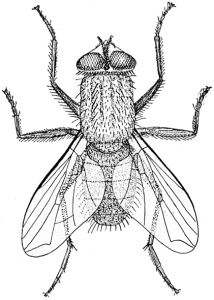 Classification of house fly
Classification of house fly
Phylum : arthropoda
Class : Insecta
Order : Diptera
Family : Muscidae
Specie : Musca domistica
Medical Importance
House fly is a potential vector of many diseases like typhoid, paratyphoid fever, diarrhea, dysenteries, cholera, gastroenteritis and amoebiasis.
Habits of House fly
The habits of housefly make it suitable for the spread of disease
Distribution: The housefly occurs all over the world.
Breeding: Housefly breeds in fresh horse manure, human excreta, garbage, decaying fruit and vegetables.
Feeding: Housefly does not bite. It is attracted to food by its sense of smell. It can not eat solid food. It vomits on solid food to make a solution of it and then suck it in a liquid state.
Defecation: The housefly has the habit of defecation constantly all the day. Thus it deposits countless bacteria on exposed food.
Dispersal: Housefly can disperse 3-4 miles from their breeding places.
General Characteristics of Housefly
The housefly is a medium size common insect, from light to dark gray in color. The body is divided into three parts:
Head: The head bear a pair of compound eyes, a pair of antenna and a retractile proboscis, which is adapted for sucking liquid food. Male eyes are closer together, while female eyes are set apart widely.
Thorax: Thorax has 2-4 well developed dark longitudinal stripes. Thorax bears a pair of wings and three pair of legs. The legs and the body are covered with short and stiff hairs, called tenent hairs which secretes a sticky substance.
Abdomen: The abdomen is 4 segmented and shows light and dark marking. In female a tube like structure is extended from the abdomen when the fly lays her eggs.
Life cycle of Housefly
The housefly undergoes a complete metamorphosis.
Egg: The female lays about 120-150 eggs in one siting. Eggs are laid in horse manure and other decaying materials. They are creamy white in color and are about 1-2 mm in length. The fly lays from 600-900 eggs during her life time. The eggs hatch in 8-24 hours.
Larva: The larva is 12 segmented, white in color and about 1-2 mm in length at birth. At the anterior and posterior end of the body a pair of spiracles are present. The larva feed on decaying organic matters. The larval period lasts from 2-7 days.
Pupa: The pupa is dark brown in color. The pupa stage lasts from 3-6 days but in winter it may be prolonged.
Adult: The complete life cycle from egg to adult may take 5-6 days during summer. Flies do not live longer than 15 days in summer and 25 days in winter.
Transmission of diseases
1. Mechanical transmission: Flies are potential vectors and efficient mechanical spreaders of many diseases and most of them can be spread by mechanical transmission. Houseflies transport microorganisms on their feet and hairy body. Pathogenic organisms, ova and cyst have been recovered from the bodies of the common housefly. Pathogens remains alive for 36 hours on their feet.
2. Vomit drops: The vomit drop is a rich bacterial culture. By its habit of repeatedly vomiting, the housefly infects foods and there by transmits disease. Infection remains alive for 8 days in vomit.
3. Defecation: The excrement of housefly has been found to contains microorganism, cyst and ova of intestinal parasites. By its habits of constant defecation, the houseflies spreads these diseases. Infection remains alive for 18 days in the feces.
Control measures
1. Protection against flies: Screening of houses, hospitals, food market, restaurant and other similar establishments will give considerable relief from houseflies. The doorways and windows should be screened. Screen should be made of non-corrosive material, such as copper or aluminum gauze.
2. Environmental control: The best way to control the housefly is to eliminate their breeding places and improvement in environmental sanitation on a community basis. All domestic refuses should be placed in strong plastic bags and the opening should be tightly closed. Regular refuse collection twice a week to prevent any egg laying among the refuses developing to adult. The refuses should be burned or buried properly. A clean house with clean surrounding is the best answer to the fly problem.
3. Insecticidal control: Commercially available aerosol dispensers are commonly used in home as a spray to kill flies. They contains knock down insecticides such as 0.5% dichlovos or 0.2% pyrethrins. Spraying of residual insecticides such as 3% malathion or 1% dimethoate are remain effective for 1-2 months. Special care should be taken to prevent contamination of food or water during spraying operation. Poisoned baits containing 1 or 2 % diazinon and malathion have been tried with success. Liquid baits containing 0.1 to 0.2% of the same insecticides and 10% sugar water have given good results.
4. Health education: It is difficult to control the flies without the co-operation of the people. Fly control campaigns require organized individuals and community efforts which is the basis of successful public health programmed. It is only through health education that people can be motivated with a desire to get rid of flies permanently.
 howMed Know Yourself
howMed Know Yourself




